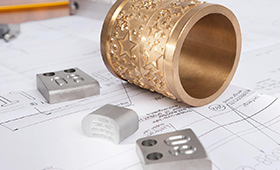Engraving, sculpting, lasering - designing with metal
Training for engravers is updated
36/2016 | Bonn, 28.07.2016

The printing plates for a banknote, the name of the cup winner, the personal message on a wedding ring - these are the tasks and the training content involved in being an engraver. Engravers increas-ingly use computer-assisted programming as well as laser techniques in addition to traditional en-graving techniques which remain a feature of the occupation to the present day. Working together with social partners and experts from company practice, the Federal Institute for Vocational Educa-tion and Training (BIBB) has therefore brought engraver training up to date on behalf of the Federal Government. Another creative metalworking occupation therefore comes into force on 1 August in an updated form and in addition to the occupation of decorative metal worker.
Engravers fabricate stamping, moulding and embossing tools. We are all familiar with their work as it is engravers who transfer and rework the motifs for stamps, coins and banknotes onto printing plates and embossing stamps. Engravers are also needed for sign manufacturing when it is necessary for front panels, control panels and interior and exterior signage to be engraved, designed in colour, and printed. They also add inscriptions, adornments, or visual representations to metal jewellery, ornamental objects and pieces of art, as well as to items made from plastic or porcelain.
It became necessary to update the three year training in view of the developments in company based practice, the occupational structure and the training content. A growing variety of materials, new metal working processes, the use of lasers as well as computer aided design and computer numerical control are changing the occupational activities of the engraver. In the future and with the inclusion of these innovations, trainees will therefore learn all about work piece design, the manual and digital production of technical drawings and patterns, the production of models and moulds through to the processing of work pieces using machining and surface modification processes.
In order to have the benefit of an integrated occupation, the previous focus areas of ‘flat engraving technology’ and ‘relief engraving technology’ were removed as both areas merge into one another and modern engraving companies offer virtually all content to the same extent. The two-part ex-tended final examination is also new. This supersedes the traditional model of the intermediate and journeyman's examination. As part of an increased focus on service provision, greater attention is also paid to the customer relationship - this includes information, advice, implementation of indi-vidual requirements and dealing with complaints.
Engravers work at metal and plastics manufacturing companies in the craft trades and industrial sectors. Skilled workers can take further qualifications to become master engravers. There is also the option of continuing education and training as a metal-working foreman and specialist degree courses. The current updated training regulation replaces the regulation last revised in 1998.
Contact at the BIBB:
Margareta Pfeifer; E-Mail: pfeifer@bibb.de
Specimen copy requested if printed.